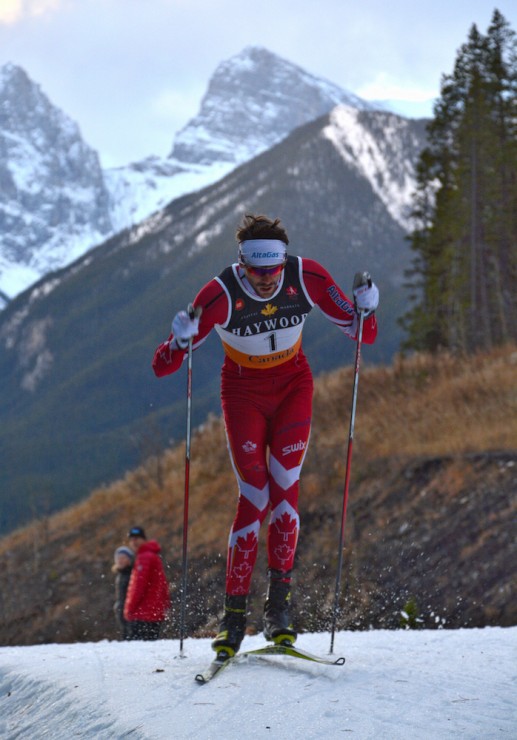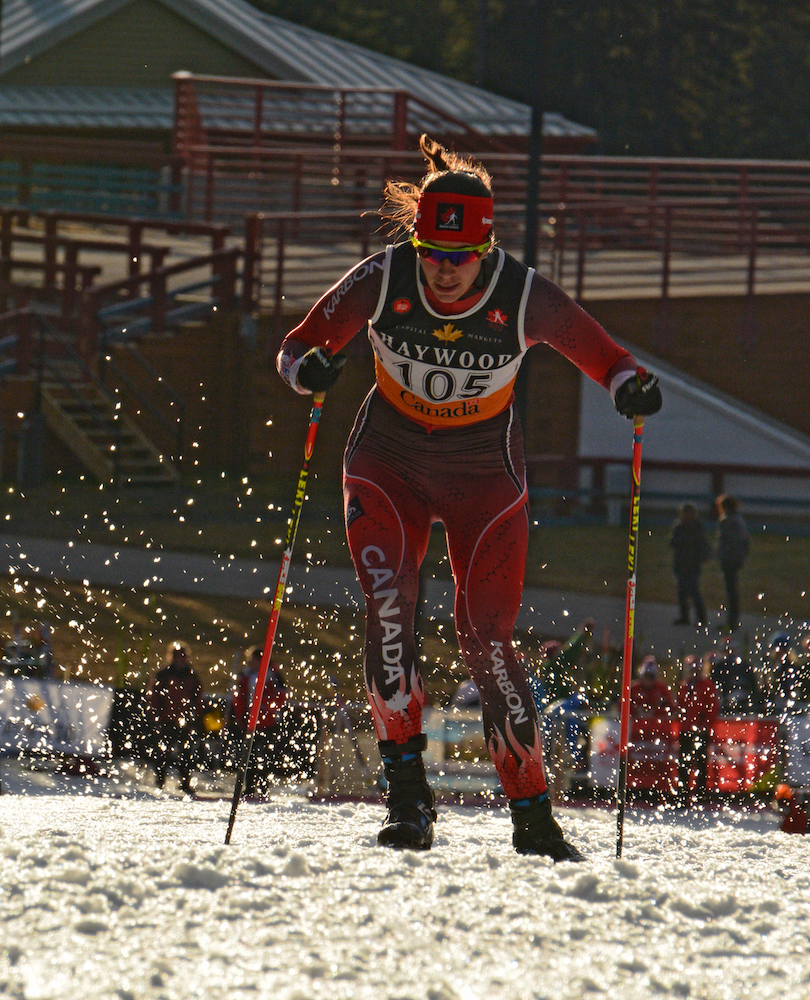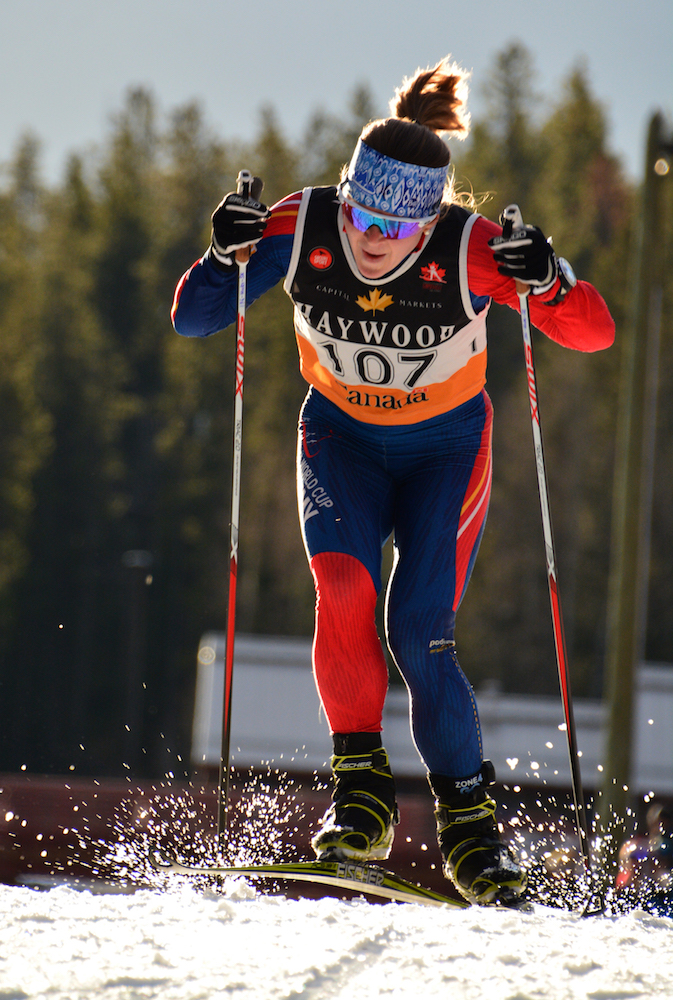
Qualification-only sprint races can be a little dull. Four minutes of pain and done. Describing the action? Even more dull.
But for Bob Thompson of the Thunder Bay National Development Centre (NDC), Thursday’s freestyle sprint qualifier in Canmore, Alberta, was one he’ll hold in his mind for a long time. For him, a 25 year old who skied his first World Cup races at home at the Ski Tour Canada last March, placing second in the Frozen Thunder skate-sprint qualifier meant a trip to Europe for his first overseas World Cups.
On Thursday, the final day of racing on Canmore’s early season snow, affectionately known as Frozen Thunder, Len Valjas (who hails from the same club as Thompson, Team Hardwood in Ontario) won the men’s qualifier in 3:25.23. Thompson’s time was just six-hundredths of a second slower, but enough to get him the final men’s quota spot for World Cup Period 1.

Valjas, a World Cup A-team member, was preselected for Period 1.
Jess Cockney, of the World Cup B-team, won Tuesday’s classic sprint qualifier to lock down the first of two selections, an achievement that was officially announced at 9 a.m. Thursday, 30 seconds before Valjas attacked the course wearing bib 1.
Two other favorites for the final World Cup spot, Julien Locke (Black Jack/NST U-25 Team) and Simon Lapointe of the Pierre-Harvey Training Centre (CNEPH) placed third and fourth, 0.22 and 1.29 seconds back, respectively. Graeme Killick, belying his distance-specialist persona, finished fifth.
“The race today was great,” Thompson wrote in an email shortly after the race. “I told [my coach] Timo [Puiras] at the finish I was happy with how I performed and followed the plan and either way I wasn’t going to say I didn’t race my best.
“I wanted to keep things controlled,” Thompson wrote of his race plan. “It’s important to keep the speed high on both laps and especially finishing the second half of the lap fast as it is mostly flat and rolling. Being able to really go the second time up the climb was what I was planning for. … Being out there and able to do that was great.”
Like many of the sprinters seeking one of two remaining men’s World Cup spots, Thompson made this week a training target.
“Timo and I had the plan made to be fast for these races since very early in the year,” he wrote. “Not much was changed other than the last few weeks of prep, dropping some volume and moving into more of a sprint intensity focused block.”
Cross Country Canada (CCC) High Performance Director Tom Holland, a member of the selection committee and chief of competition for these races, studied the race closely.
“Watching this morning, I wouldn’t call it tactics,” Holland said on the phone. “But the way people can ski corners, probably made the difference between who was the winner and who was second.”
To put that in context, the difference between first and third was 0.22 seconds, or 1.5 metres at an average speed of 25 kilometers per hour. It wouldn’t take much of a difference to gain or lose that five feet.
Last spring, CCC and a group of coaches decided on the using the sprint qualifiers to fill out the team for World Cup Period 1.
“The results show … that there’s five or six guys here that are reasonably close,” Holland said of the level of competition in Canada.
Of those top skiers, CCC wanted to determine “who could do a qualifier fast for the World Cup and try to match it up with some of the courses they’ll be skiing in November and December.”
The course held up fairly well for the men, despite the warm weather, with all the selection favourites starting within a five-minute period.

“The track had broken down and was soft where the guys had skied,” women’s second-place finisher Olivia Bouffard-Nesbitt wrote in an email. “But there were a few sections of fast, firm snow to be found near the edges of the trail.”
The women started after all 34 men had completed two laps.
Biathlon Canada’s Rosanna Crawford won the women’s qualifier in 3:58.20, followed by Bouffard-Nesbitt, 3.02 seconds behind, and Caitlin Gregg (Team Gregg/Madshus) in third (+4.5).
“Conditions were a little bit mixed with some harder, almost icy sections and then some really soft, deep and slushy sections,” Gregg wrote of the course. “The conditions were the same for everyone so I don’t think it affected the results. I did speak to some other athletes afterwards who agreed that the conditions were tricky to master and really good practice!”
“It was a fun race, super quick!” Crawford wrote in an email. “The Frozen Thunder loop is interesting, there’s always a hill and then a break, so you are able to push harder than on a normal race course I would say.”
Four women were preselected to fill Canada’s women’s quota of three plus Continental Cup winner Dahria Beatty for World Cup Period 1: Emily Nishikawa (World Cup B-team), and U-25 Team members Beatty, Cendrine Browne and Maya MacIssac-Jones.
On the men’s side, Canada’s quota is six plus Continental Cup winner Andy Shields. For the first period of the World Cup, it will field an eight-person team of Thompson and Cockney, and preselected athletes Alex Harvey, Devon Kershaw, Valjas, Killick, Knute Johnsgaard, and Shields.
Note: The information regarding Canada’s World Cup team quota has been updated to reflect that four women total can start for Canada in Period 1.
— Alex Kochon contributed

FasterSkier is seeking photos from the 2016 races at Frozen Thunder. Please email submissions with caption and credit info to info@fasterskier.com.



